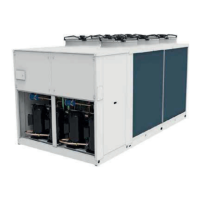
Do you have a question about the HIdRos LHA P4U Series and is the answer not in the manual?
| Refrigerant | R410A |
|---|---|
| Max. Water Temperature | 55°C |
| Type | Air to Water Heat Pump |
| Heating Capacity | 4.0 - 16.0 kW |
| Power Supply | 220-240V, 50Hz |
| COP (Heating) | 4.0 |
| Noise Level | 50 dB(A) |
General information about the manual, its purpose, and reproduction policy.
Highlights the importance of consulting the manual before any operation for safety.
Details potential risks associated with unit components and methods of injury.
Explains the purpose of the rating plate and where to find unit identification details.
Identifies refrigerant type, lubricant, and main ecological information regarding refrigerants.
Provides warnings and guidelines for handling refrigerants safely to prevent damage or injury.
Provides first aid procedures for exposure to refrigerants, including inhalation and contact.
Describes the high efficiency air/water heat pump series and its core capabilities.
Presents performance data, energy efficiency, and sound levels for various models.
Shows graphical representations of operating limits based on ambient and water temperatures.
Tabulated sound power and pressure levels for various unit models and octave bands.
Emphasizes safety precautions and the use of warning symbols during installation.
Lists essential PPE like footwear, eye protection, gloves, and respiratory gear.
Specifies installation site requirements and minimum clearances for air and maintenance.
Crucial safety warnings and guidelines for electrical connections.
Provides schematic diagrams of the refrigerant circuit for P4S and P4U versions.
Lists essential checks before starting the unit to prevent damage and ensure correct operation.
Details critical checks and pre-heating requirements before initial unit operation.
Explains how to start the unit using the keyboard or remote ON/OFF input.
Details how to change set points for heating, cooling, and hot water modes.
Accessing service menus and entering passwords for different security levels.
Outlines regulatory obligations and general safety precautions for maintenance.
Details periodic inspection and maintenance requirements based on regulations.
Lists essential checks performed by trained personnel before and during service.
Procedures for safely disconnecting the unit by authorized personnel.
Guidelines for dismantling, sorting, and disposing of unit components responsibly.
Provides a table of unit alarms, their causes, and recommended solutions.
